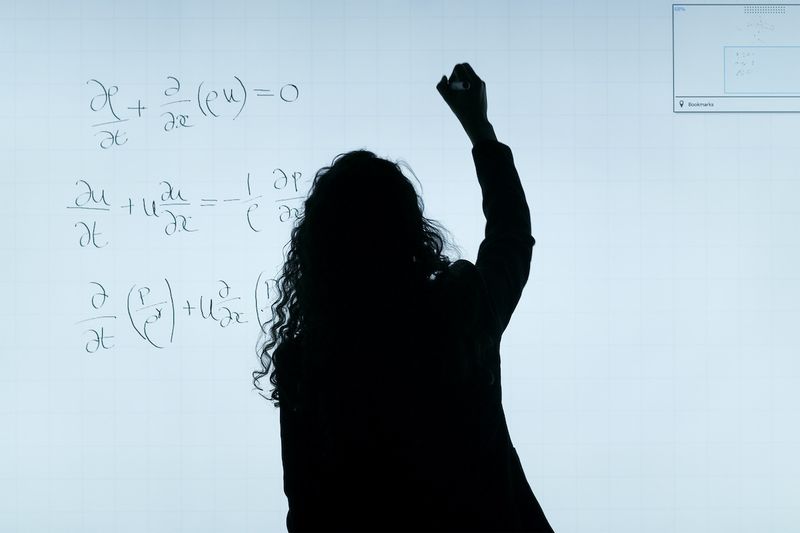
Matemáticas (or matemática), mates, math or mathematics… hated by some, loved by others. Do you like math? Some of us struggled with math in school, others excelled. The reality is that whether we like math or not, it is part of our daily life. We use it when paying our bills, budgeting, leaving a tip at a restaurant, cooking, figuring out distance, time, cost of things, and even sports! Other fields such as biology, chemistry, psychology, music, art, sculpture, and economics also use math as a tool.
In this article you will learn basic mathematical terms that you probably already know; you will also learn more advanced vocabulary that may be new to you and, hopefully, you find them useful.
Let’s start with the very basics! If you know these terms, it’s still a good refresher:
La aritmética or Arithmetics studies numerical operations like addition, subtraction, multiplication, and division. Are you familiar with the following terms?
¡Ojo! To add in Spanish use the word más to indicate plus, and use either the singular or the plural form of ser to indicate the equals sign: Tres más tres es seis. Tres más tres son seis. Three plus three is six. Same with subtraction (menos), multiplication (por), and division (dividido por/entre).
Fun Fact! Did you know there is no Roman numeral for cero (zero)? The Roman number system was designed to estimate the prices of goods so they didn’t need any value to represent zero.
Here are some common math symbols, can you think of any more to add to the list?
Fun fact! Did you know Pi is the Latin name of the sixteenth Greek letter, π? In Spanish we pronounce it [PEE], like the letter P in English.
La geometría or Geometry is the study of space, such as distance, shape, size, and relative position of figures.
El álgebra or Algebra is the study of abstract structures, it helps represent problems or situations in the form of mathematical expressions. Have you heard of any of the following terms?
La estadística or Statistics is the study of the collection, analysis, interpretation, presentation, and organization of data. Statistics helps us make informed decisions by tracking progress, measuring performance, analyzing problems, and prioritizing tasks. Take a look at these useful terms:
Now that we’ve covered some of the more basic terms, let’s take a look at more complex ones. You may know these from school, work, or these may be completely new to you!
La teoría de conjuntos or Set Theory is a branch of mathematical logic where we learn sets and their properties. A set is a collection of objects or groups of objects. These objects are often called elements or members of a set. For example, a group of players in a basketball team is a set. These are some common terms:
La teoría de números or Number Theory is a branch of pure mathematics devoted primarily to the study of the integers and arithmetic functions. Here are some useful terms:
La trigonometría or Trigonometry is a branch of mathematics concerned with relationships between angles and ratios of lengths. Take a look at these terms:
El Cálculo or Calculus is the study of change and continuity (more specifically, continuous, as opposed to discrete, change ). Infinitesimal calculus is divided into two areas: cálculo diferencial (differential calculus) and cálculo integral (integral calculus).
La combinatoria or Combinatorics is the mathematics of counting and arranging. It applies mathematical operations to count quantities that are too large to be counted the traditional way. It is especially useful in computer science.
La teoría de juegos o Game Theory is the science of strategy, or at least the optimal decision-making of independent and competing actors in a strategic setting.
Calculadora / Calculator: Los estudiantes no pueden utilizar la calculadora para el examen de matemáticas. (Students are not allowed to use the calculator for the math exam.)
Contar / To count: A Susana le ayuda contar ovejas para dormirse. (It helps Susana to count sheep to fall asleep.)
División / Division: Dividamos este pastel entre cinco trozos. (Let's divide this cake into five pieces.)
Media / Average: Los adolescentes pasan una media de 8 horas diarias frente a las pantallas. (Teens spend an average of 8 hours on screens per day.)
Multiplicación / Multiplication: El número de niños que tienen un teléfono móvil se ha multiplicado en los últimos años. (The number of kids who have a cell phone has multiplied in recent years.)
Números romanos / Roman numerals: Los números romanos se utilizan para nombrar los siglos. (Roman numerals are used for naming centuries.)
Paréntesis / Parentheses: Los paréntesis agrupan ciertos números para indicar cuáles son las operaciones que deben realizarse primero. (Parentheses group certain numbers together to indicate which operations should be performed first.)
Pirámide / Pyramid: Una pirámide alimenticia es una buena manera de ilustrar qué alimentos componen una dieta sana. (A food pyramid is a great way to illustrate what foods make up a healthy diet.)
Porcentaje / Percentage: En los restaurantes en Estados Unidos, se suele dejar de propina entre un 15 y un 20 por ciento del total de la cuenta. (In restaurants in the United States, it is customary to tip between 15 and 20 percent of the total bill.)
Radio / Radius: Hay muchos restaurantes en un radio de tres kilómetros. (There are many restaurants within a two-mile radius.)
Resta / Subtraction: Para saber qué hora es en Chicago, resta una hora si vives en la hora central del Este.. (To find out what time it is in Chicago, subtract one hour if you live in Eastern Central Time.)
Suma / Addition: Para calcular tu numerología suma todos los números de tu fecha de nacimiento. (To calculate your numerology add up all the numbers of your birth date.)
Tabla de multiplicar / Times table: La tabla de multiplicar del 1 es la más fácil. (The 1 times table is the easiest.)
¡Ojo! Do you remember the prepositions entre or por? In other non-mathematical contexts, these words mean between and by/through/along respectively. Same thing happens with más, aside from meaning plus, in other contexts it can be translated as more, most, further. What about menos? Aside from minus, do you remember what else it means in other contexts?
You made it! Whether you need to know math vocabulary in Spanish for school, work, or you just love math AND Spanish, you now have a very comprehensive guide with many terms for you to study and reference. We covered from the very basics to some advanced material.
Now let’s practice some basic terms!
Let’s practice some of the terms you learned. Don’t worry! You are not being tested on how to calculate a cosine of an angle, just some vocabulary in Spanish!
A. Cono
B. Triángulo
C. Cuadrado
D. Círculo
E. Pentágono
***********************
Answer Key:
***********************
Answer Key:
A. Mayor que
B. Menor que
C. Paréntesis
D. Porcentaje
E. Igual
***********************
Answer Key:

Alicia Fernández is a content writer at Berges Institute.